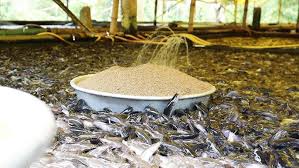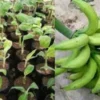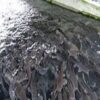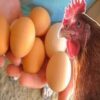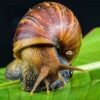Good nutrition in animal production systems is essential to economically produce a healthy, high-quality product. In fish farming, nutrition is critical because feed represents 40-50% of the production costs.
Fish nutrition has advanced dramatically in recent years with the development of new, balanced commercial diets that promote optimal fish growth and health. The development of new species-specific diet formulations supports the aquaculture (fish farming) industry as it expands to satisfy increasing demand for affordable, safe, and high-quality seafood products.
What is Fish Feed?
To consider what a living animal needs to feed on, the first thing that comes to mind is to cover the energy requirements to ensure basic vital functions (moving, growing, reproduction, and metabolism). The energy for these functions is provided by the intake and uptake (metabolism) of proteins, fats (lipids), and carbohydrates contained in the food.
Additionally, the animal needs certain substances to grow and function properly, such as vitamins and minerals, which play a secondary but essential role in the body.
In this respect, fish are not so different from other animals, needing to eat to live, grow, and reproduce. However, farmed fish are somewhat special compared to other farmed animals because most farmed fish species in Western Europe are highly carnivorous (salmon, trout, sea bass, sea bream, turbot, etc.).
They therefore require a high level of proteins in their diets. Feed manufacturers have a common goal to produce feeds that are nutritious, easy to handle, and economically acceptable in the production chain. If these criteria are met, this allows the production of affordable, high-quality fish for the consumer.
Read Also: Sheep gene insights could help farmers breed healthier animals
Supplementary Diets in Fish Farming

Two concepts of supplementary diets have recently been recognized. One school of thought defines it as a supplement fed along with another, while another regards it as one fed to supplement the natural food present in the environment.
The latter definition was accepted and adopted by aquaculture experts. Feed industries in Nigeria are characterized by constant fluctuations in the prices of feed ingredients. This is practically due to the seasonality of most of these feedstuffs and also because of several alternative uses of the ingredients, especially in poultry and livestock industries, and even for human consumption.
These shortcomings have necessitated the use of alternative feed ingredients for possible inclusion in the diet of farmed fish and as a total replacement for fishmeal where possible.
However, it is noteworthy that in finding a replacement, the aim of producing high-quality food (fish) for human consumption that is environmentally friendly, cost-effective, and sustainable must not be compromised.
These occurrences have been traced to the presence of elements within vegetable meals that inhibit the nutrition of fish species. These elements, called antinutritional factors, have the potential to precipitate adverse effects on the productivity of farm livestock, including fish, and are found in the foliage and/or seeds of virtually every legume plant used in practical feeding.
In the quest to find alternative protein sources using locally available materials in fish feed preparations, many attempts and successes have been recorded. However, it has been pointed out that most of the feed ingredients have not performed credibly well in terms of their protein digestibility and biological value to fish when tested as replacements for fishmeal.
With the unequal position occupied by fishmeal as the “chief protein source” due to its balanced amino acid composition in the diet of fish and livestock, it is therefore a better practice that a vegetable protein be made to replace another in practical fish feed formulations.
Fish Meal as a Key Component of Fish Feed
For the production of high-quality fish, most of the fish species farmed around the world, including catfish, which is popular in Nigeria, are essentially omnivorous and carnivorous. Their metabolism requires access to fish or fish materials in their feed. Fishmeal is composed of the following materials.
1. Fishmeal
Fishmeal is a high-protein feedstuff often included in poultry diets. It is usually marketed at 65% crude protein, but the crude protein content can vary from 57 to 77%, depending on the species of fish used. Several species of fish can be processed into fishmeal, but the most common are anchovy and menhaden. Major fishmeal-producing countries are Chile, Norway, Denmark, and Peru.
Most fish species cannot be harvested year-round. As a result, there is seasonal variation in protein content, depending on the species of fish used. The crude protein content of fishmeal is usually highest during the menhaden harvest. The price of fishmeal varies throughout the year and reflects the seasonal variation in the supply of fish.
The price of fishmeal is usually highest during the winter months when the supply is lowest. The price also varies from year to year depending on the price of other protein sources, particularly soybean and other oil meals.
Fishmeal coming from pelagic fish, which are the most used to supply fish oil and fishmeal, is generally unsuitable for human consumption because they are small and bony, making it economically unviable to process them into products adapted to consumer needs.
To cover all the dietary requirements of carnivorous fish, the feed must be high in energy content. This means it has to be protein-rich (from 38% to 45% according to the needs of each species). It also has to be of good quality, highly digestible, and have amino acid profiles adapted to the nutritional requirements of the fish species in question.
2. Fish Oil
Fish oil is also obtainable from pelagic fish. Apart from essential proteins, the food must also cover the particular requirements for oils. Key requirements are the healthy Omega-3 and Omega-6 polyunsaturated fatty acids, which control vital life processes, including reproduction, physical development (especially of the brain and nervous system), immunity, inflammatory processes, and a healthy cardiovascular system.
Pigments such as astaxanthin, a naturally occurring carotenoid pigment, are powerful biological antioxidants and are essential for protection against UV-light effects and stimulating the immune response. Wild fish obtain this natural pigment from eating tiny crustaceans.
3. Vitamins
Vitamins A, C, D, and E, the B group, and others, such as biotin, are readily available in fishmeal. Similarly, vegetable products such as cereals, soybean, glutens, and vegetable proteins are increasingly used in modern fish feeds, as some of these have been found to contain these mineral elements and vitamins.
A lot of research has shown that vegetable sources of protein (soy, pea, sunflower) and oils (soy, colza, linen) are perfectly usable in varying proportions in fish feed. At present, fishmeal and oils represent around 50% or less of certain formulations. In the near future, their percentage will be reduced even further.
4. Moisture
The moisture content of fishmeal is normally low to facilitate storage and transport. If the moisture content remains at the acceptable lower limits, the meal will likely have a low bacterial and/or mold count. Antioxidants must be added to the meal to ensure proper stabilization during extended periods of storage. Fishmeal contains three major nutrients: protein, fat, energy, and minerals (ash).
5. Other Ingredients
In Nigeria, many agricultural and industrial by-products have been identified and proven useful in fish feed formulation. Notable among these are groundnut cake, soybean cake, brewery waste, biscuit waste, palm kernel cake, rice bran, and others.
Nutritional Requirements of Fish
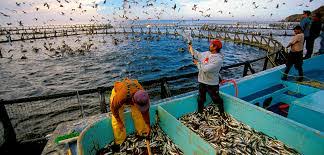
Fish, like any other livestock, especially those farmed for commercial purposes, need food to sustain themselves and carry out metabolic activities such as growth, respiration, reproduction, and other life processes.
The nutritional requirements for meeting such demands are those that enhance tissue buildup, chemical synthesis, and energy provision, among others.
Therefore, a properly formulated and prepared feed must have a well-balanced energy-to-protein ratio. The following nutrient sources are essential parts of a fish diet to ensure good returns for the fish farmer.
1. Protein
Fishmeal is added to fish and poultry diets as a source of highly digestible, high-quality animal protein. Animals synthesize proteins from 22 amino acids. However, animals cannot synthesize all 22 of these amino acids.
Amino acids that cannot be synthesized by animals and must be supplied in the diet are classified as essential. Those that can be synthesized by the animal are termed nonessential. Of these, a few cannot be synthesized at a rate fast enough for maximum growth and are therefore considered dietary essentials in fish feed.
The nutritional value of any protein is directly related to its amino acid composition. A protein that does not contain the proper amount of required (essential) amino acids would be imbalanced and have a lower nutritional value to the fish.
Proteins of cereal grains and most other plant protein concentrates fail to supply the complete amino acid needs of fish due to a shortage of methionine and/or lysine. Soybean meal, widely used in poultry diets, is a good source of lysine and tryptophan but is low in sulfur-containing amino acids like methionine and cysteine.
Fishmeal is an excellent source of all these amino acids. A well-balanced protein, such as that found in fishmeal, is considered to be of high nutritional value for fish.
Feedstuffs are combined to meet the fish’s need for the most limiting amino acids, as well as other nutrients and energy. This can sometimes result in a higher-than-required protein content of the diet due to the presence of other amino acids in excess.
The excess amino acids are not used for protein synthesis. Instead, they are deaminated, and their carbon skeletons are used as an energy source or stored for later use. This method of furnishing excess amino acids is expensive and inefficient.
Using synthetic amino acids, diets can be formulated to meet the fish’s amino acid requirements with a reduced total protein content. This provides appropriate levels of essential amino acids while avoiding large excesses of other amino acids.
Fishmeal contains an excellent quantity and profile of amino acids, which can also offset the deficiencies of certain limiting amino acids in cereal grains. The protein in fishmeal is an excellent source of essential amino acids like lysine, methionine, and tryptophan. This is why fishmeal is often used as the supplement of choice for vegetable protein, especially soybean meal.
2. Minerals (Ash)
Minerals are inorganic elements necessary in the diet for normal body functions. They can be divided into two groups (macro-minerals and micro-minerals) based on the quantity required in the diet and the amount present in fish.
Common macro-minerals are sodium, potassium, chloride, and phosphorus, while examples of micro-minerals include copper, chromium, iodine, zinc, and selenium.
These minerals regulate osmotic balance in fish and aid in bone formation and integrity. Fishmeal is an excellent source of calcium and phosphorus for fish.
The ash (mineral) content of fishmeal can range from 10 to 25%. The higher ash content usually indicates a higher calcium and phosphorus level. The calcium and phosphorus are in a highly available form, unlike some of the calcium and phosphorus in plant proteins.
One of the only minerals in fishmeal that is not readily available to fish is the trace mineral selenium. The selenium in fishmeal exists in the form of selenoproteins, which are not considered to provide readily available selenium to fish.
Fish can also absorb many minerals directly from the water through their gills and skin, allowing them to compensate to some extent for mineral deficiencies in their diet.
3. Energy
The energy content of fishmeal is directly related to the percentage of protein and oil (fat) in the meal. Usually, the metabolizable energy (ME) value of fishmeal ranges from 2500 to 3200 Kcal ME/kg. The quantity of oil present in fishmeal depends on the species, feeding habits of the fish, and the method of processing.
The use of antioxidants in the preservation of fishmeal is essential to ensure a higher ME value for fish and poultry. Without stabilizing the fishmeal with antioxidants, the ME of the meal may be reduced by as much as 20%.
Prior to the development and use of antioxidants by the fishmeal industry, it was common practice to turn piles of processed meal to dissipate the heat arising from the oxidative process.
Occasionally, these piles of stored meal or fishmeal in transit would combust spontaneously, causing fires and decreasing the nutritive value. It was common several years ago to hear of ships sinking due to fires caused by the spontaneous combustion of fishmeal. Today, transatlantic transported fishmeal, by law, must contain an effective antioxidant.
4. Fatty Acids
The oil present in stabilized meal has a relatively low concentration of linoleic acid, an essential fatty acid for poultry. However, the oil is an excellent source of the essential fatty acid, linolenic acid. The fatty acids present in the oil in fishmeal can contribute to the requirement of poultry for essential fatty acids.
Supplementing low levels of fishmeal in broiler and laying hen diets has been shown to increase the omega-3 fatty acid content of broiler meat and eggs. Current knowledge in the area of cardiovascular disease indicates that the presence of omega-3 fatty acids in the human diet is related to a lower incidence of heart attacks.
5. Vitamins
Vitamins are organic compounds necessary in the diet for normal fish growth and health. They are often not synthesized by fish and must be supplied in the diet. The two groups of vitamins are water-soluble and fat-soluble. Water-soluble vitamins include the B vitamins, choline, inositol, folic acid, pantothenic acid, biotin, and ascorbic acid (vitamin C). Of these, vitamin C is probably the most important because it is a powerful antioxidant and helps the immune system in fish.
The fat-soluble vitamins include A vitamins (retinols), D vitamins (cholecalciferols), E vitamins (tocopherols, antioxidants), and K vitamins (menadione). Of these, vitamin E receives the most attention for its important role as an antioxidant. Deficiency of each vitamin has certain specific symptoms, but reduced growth is the most common symptom of any vitamin deficiency. Scoliosis and dark coloration may result from deficiencies of ascorbic acid and folic acid, respectively.
Read Also: 17 Medicinal Health Benefits Of Mucuna pruriens (Monkey Tamarind)
Types of Fish Feed
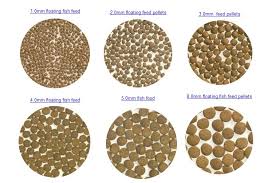
Commercial fish feeds are manufactured as either extruded (floating or buoyant) or pressure-pelleted (sinking) feeds. Both floating and sinking feeds can produce satisfactory growth, but some fish species prefer floating, while others prefer sinking. Shrimp, for example, will not accept floating feed, but most fish species can be trained to accept a floating pellet.
Extruded feeds are more expensive due to higher manufacturing costs. Usually, it is advantageous to feed a floating (extruded) feed. This enables the farmer to directly observe the feeding intensity of the fish and adjust feeding rates accordingly, which is an important management strategy in ensuring maximum fish growth and feed use efficiency.
As mentioned earlier, manufactured feeds are available in a variety of sizes, ranging from fine crumbles for small fish (fry, swim-up fry) to large sizes. The pellet size should be approximately 20-30% of the size of the fish species’ mouth gape.
Feeding too small a pellet results in inefficient feeding and feed utilization because more energy is used in finding and eating more pellets. Conversely, pellets that are too large for the fish’s mouth will depress feeding and, in extreme cases, cause choking. Therefore, the appropriate feed size for the right fish ensures active feeding.
Feeding Rate, Frequency, and Timing
Feeding rates and frequencies are, in part, a function of fish size. Small larval fish and fry need to be fed a high-protein diet frequently and usually in excess.
Small fish have a high energy demand and must eat nearly continuously, being fed almost hourly. Feeding small fish in excess is not as much of a problem as overfeeding larger fish because small fish require only a small amount of feed relative to the volume of water in the culture system.
As fish grow, feeding rates and frequencies should be lowered, and protein content reduced. However, rather than switching to a lower-protein diet, feeding less allows the grower to use the same feed (protein level) throughout the grow-out period, thereby simplifying feed inventory and storage.
Feeding fish is labor-intensive and expensive. Feeding frequency is dependent on labor availability, farm size, and the fish species grown. Large catfish farms with many ponds usually feed only once per day due to time and labor limitations, while smaller farms may feed twice per day.
Generally, growth and feed conversion increase with feeding frequency. In indoor, intensive fish culture systems, fish may be fed as many as five times per day to maximize growth at optimum temperatures.
Feed acceptability, palatability, and digestibility vary with the ingredients and feed quality. Fish farmers pay careful attention to feeding activity to help determine feed acceptance, calculate feed conversion ratios and feed efficiencies, monitor feed costs, and track feed demand throughout the year. The recommended feeding rate for farmed fish is between 1-4% of their body weight per day.
Feed Formulations, Care, and Packaging
The composition of the feed changes according to the nutritional needs of the fish. When it is a larva, it requires a high protein level since it needs this resource for the growth of its muscle tissue. Lipids (fats) are used by fish as their main energy source, and as they grow bigger and more active, the lipid content is increased, and the protein content is reduced.
Prepared or artificial fish feed may be either complete or supplemental. Complete diets supply all the ingredients (protein, carbohydrates, fats, vitamins, and minerals) necessary for optimal growth and health of the fish. When fish are reared in high-density indoor systems or confined in cages and cannot forage freely on natural feeds existing in ponds, they must be provided with a complete diet.
In contrast, supplemental (incomplete/partial) diets are intended only to help support the natural food (insects, insect larvae, algae, small fish, and other benthic organisms) normally available to fish in ponds or outdoor raceways. Supplemental diets do not contain a full complement of vitamins or minerals but are used to help fortify the naturally available diet with extra protein, carbohydrates, and/or lipids.
Fish, especially when reared in high densities, require a high-quality, nutritionally complete, balanced diet to grow rapidly and remain healthy. Prepared feeds are pelleted to enhance better utilization by fish, but the size of feeds varies because each size corresponds to the different stages of development and the physiology of the fish.
To ensure well-fed fish, pellets are adapted to the development of the fish’s mouth size, which varies according to its age and species. Imported dry feed exists in sizes ranging from crumble-size (0.08 mm diameter) to big pellets (20 mm diameter), with several other sizes within the range.
Bagged feeds should be kept out of direct sunlight and as cool as possible. Vitamins, proteins, and lipids are especially heat-sensitive and are readily denatured by high storage temperatures.
High moisture stimulates mold growth and feed decomposition. Avoid unnecessary handling and damage to feed bags, which may break the pellets and create fines that may not be consumed by fish.
Do you have any questions, suggestions, or contributions? If so, please feel free to use the comment box below to share your thoughts. We also encourage you to kindly share this information with others who might benefit from it. Since we can’t reach everyone at once, we truly appreciate your help in spreading the word. Thank you so much for your support and for sharing!
Read Also: 4 Steps to help an Orange Tree Produce Sweet Oranges

